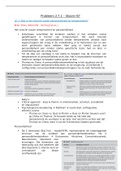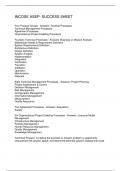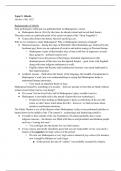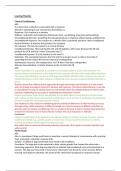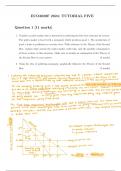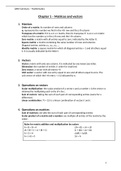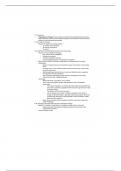- A state of political tensions between nations characterized by threats and
suspicions over different ideologies.
Origins of the cold war:
- Tensions between West (capitalist/ democratic/ liberal) and East (communist/
totalitarian/ state control) since 1917 – conflict of ideologies.
- Fear and mistrust from beginning of Bolshevik Revolution.
- Lenin outspoken capitalist critic.
- USA government did not recognize the communist government.
- No trade 1918-1924, resumed in 1924 but suspicion remained.
- Unconventional methods had to be used because each side possessed the
means of destroying the other, nuclear weaponry (M.A.D)
- Russia and the west had been ideologically divided since the Russian revolution.
The soviet view: feared encirclement and dominance of capitalism.
The Western view: Russia was expansionist and wanted communism to
dominate.
- Russia used World War 2 to embark on a policy of territorial expansion.
End of World War 2:
- War ended on. the 1 September 1945, with the dropping of the atomic bombs on
the Japanese islands of Hiroshima -’Little Boy’ (6 August 1945) and Nagasaki
- ’fat man’ (9 august 1945).
Tehran conference (Iran, 1943)
- Before the war had ended.
- Discussed military strategy.
- Western powers were given some ideas of the peace settlement envisaged by
Russia and because the western powers were still struggling with Japan, they
needed Russian support and willing to recognize Russia's expansionist
demands.
- Joseph Stalin (USSR), Franklin Roosevelt (USA) and Winston Churchill.
Yalta conference (Ukraine, February 1945)
- Western powers forced to recognize the influence of the Soviet Union (soviet
troops in Eastern Europe).
- Stalin was persuaded to support the Declaration of liberated Europe which
called for free elections of the interim governments.
- Stalin accepted France as the fourth power.
, - Germany was to pay $20 million in reparations (half goes to USSR).
- Russia invited to join UN.
- Joseph Stalin, Franklin Roosevelt, Winston Churchill.
Potsdam conference (July, 1945)
- The problem of reparations increased hostilities.
- Russia wanted reparations to be paid in industrial machinery but it would have to
of been taken out the allied zones, but have failed to provide food.
- Germany and its capital Berlin, were divided into 4 zones and each zone was
occupied by one of the allies.
- Clement Atlee (Great Britain), Harry S Truman (USA), Joseph Stalin (USSR).
Relations worsened when USA ended Russia’s financial assistance and denied a huge
loan until free elections had been held in Eastern Europe.
Iron curtain: March 1946, Fultan (Massuri)
- Winston Churchill describes the division between Soviet occupied territory from
the rest of Europe.
- Each attempted to gain more power created by fall of Germany, each believing
that its own system was key to future prosperity.
How did the USSR create a ‘sphere pf influence’ in Europe by 1949?
- Russia’s interference in Eastern Europe led to 90 million people being brought
under communist rule.
- In order to consolidate her authority over these people, USSR established an
organization Cominform (1947).
- Cominform: a body created for the exchange of communist information and to act
as a propaganda machine. (Response to Truman doctrine – policy of
containment)
- Stalin gained influence over countries next to it to act as a buffer against future
attacks from the west.
- Ussr influence on Eastern Europe by imposing strict discipline on communist
parties to ensure that they came into power:
• Czechoslovakia
• Hungary
• Bulgaria
• Romania
• Poland
- All elected governments which had communist representations.
- These countries were known as the USSR satellite states as they were not
completely controlled by Russia but were heavily influenced by it.
suspicions over different ideologies.
Origins of the cold war:
- Tensions between West (capitalist/ democratic/ liberal) and East (communist/
totalitarian/ state control) since 1917 – conflict of ideologies.
- Fear and mistrust from beginning of Bolshevik Revolution.
- Lenin outspoken capitalist critic.
- USA government did not recognize the communist government.
- No trade 1918-1924, resumed in 1924 but suspicion remained.
- Unconventional methods had to be used because each side possessed the
means of destroying the other, nuclear weaponry (M.A.D)
- Russia and the west had been ideologically divided since the Russian revolution.
The soviet view: feared encirclement and dominance of capitalism.
The Western view: Russia was expansionist and wanted communism to
dominate.
- Russia used World War 2 to embark on a policy of territorial expansion.
End of World War 2:
- War ended on. the 1 September 1945, with the dropping of the atomic bombs on
the Japanese islands of Hiroshima -’Little Boy’ (6 August 1945) and Nagasaki
- ’fat man’ (9 august 1945).
Tehran conference (Iran, 1943)
- Before the war had ended.
- Discussed military strategy.
- Western powers were given some ideas of the peace settlement envisaged by
Russia and because the western powers were still struggling with Japan, they
needed Russian support and willing to recognize Russia's expansionist
demands.
- Joseph Stalin (USSR), Franklin Roosevelt (USA) and Winston Churchill.
Yalta conference (Ukraine, February 1945)
- Western powers forced to recognize the influence of the Soviet Union (soviet
troops in Eastern Europe).
- Stalin was persuaded to support the Declaration of liberated Europe which
called for free elections of the interim governments.
- Stalin accepted France as the fourth power.
, - Germany was to pay $20 million in reparations (half goes to USSR).
- Russia invited to join UN.
- Joseph Stalin, Franklin Roosevelt, Winston Churchill.
Potsdam conference (July, 1945)
- The problem of reparations increased hostilities.
- Russia wanted reparations to be paid in industrial machinery but it would have to
of been taken out the allied zones, but have failed to provide food.
- Germany and its capital Berlin, were divided into 4 zones and each zone was
occupied by one of the allies.
- Clement Atlee (Great Britain), Harry S Truman (USA), Joseph Stalin (USSR).
Relations worsened when USA ended Russia’s financial assistance and denied a huge
loan until free elections had been held in Eastern Europe.
Iron curtain: March 1946, Fultan (Massuri)
- Winston Churchill describes the division between Soviet occupied territory from
the rest of Europe.
- Each attempted to gain more power created by fall of Germany, each believing
that its own system was key to future prosperity.
How did the USSR create a ‘sphere pf influence’ in Europe by 1949?
- Russia’s interference in Eastern Europe led to 90 million people being brought
under communist rule.
- In order to consolidate her authority over these people, USSR established an
organization Cominform (1947).
- Cominform: a body created for the exchange of communist information and to act
as a propaganda machine. (Response to Truman doctrine – policy of
containment)
- Stalin gained influence over countries next to it to act as a buffer against future
attacks from the west.
- Ussr influence on Eastern Europe by imposing strict discipline on communist
parties to ensure that they came into power:
• Czechoslovakia
• Hungary
• Bulgaria
• Romania
• Poland
- All elected governments which had communist representations.
- These countries were known as the USSR satellite states as they were not
completely controlled by Russia but were heavily influenced by it.

